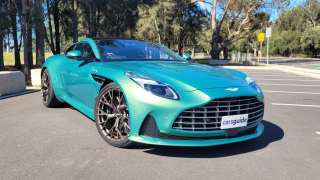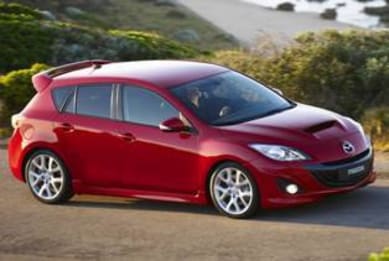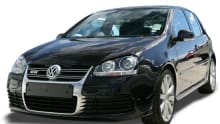
Used Mazda 3 review: 2009-2013
- Mazda 3
- Mazda 3 2009
- Mazda 3 2010
- Mazda 3 2011
- Mazda 3 2012
- Mazda 3 2013
- Mazda 3 Reviews
- Mazda Reviews
- Mazda Sedan Range
- Mazda Hatchback Range
- Sedan
- Hatchback
- Mazda
- Used Car Reviews
- Family Cars

What we like
- Well equipped base model
- Cabin ergonomics
- Optional SKYACTIV engine
What we don't
- No auto option for diesel
- No parking aids
What we like
- Well equipped base model
- Cabin ergonomics
- Optional SKYACTIV engine
What we don't
- No auto option for diesel
- No parking aids
Who'd have thought it, a Mazda knocking off the likes of Ford, Holden and Toyota to become the most popular car on the Australian market?
As astounding as that may seem, it's true; the Mazda3 'zoom-zoomed' to the very top of the sales charts in 2011 and 2012.
The Mazda3 replaced the 323 in 2004 and by 2009 when the new BL model was launched it was well established as one of the most popular small cars on the market and sales surged even higher.
A conventional front-wheel drive (FWD) small car, the Mazda3 came in sedan and five-door hatch styles and boasted a comprehensive range of models that appealed to a wide variety of buyers, all the way from singles to families and sports-minded enthusiasts.
Models
The Neo opened the BL offering. It was available as a sedan and hatch, with a 2.0-litre engine and the choice of manual gearbox or automatic transmission.
Despite being the entry model it was quite well equipped. It came standard with air-conditioning, although it wasn't climate control, and also had six-speaker stereo sound with a CD player, MP3 compatibility, remote keyless central locking, variable intermittent wipers, multi-function control screen, power windows and mirrors, cloth trim, cup and bottle holders, adjustable steering column, a tacho, a trip computer, and metallic paint.
The only option you could have was a safety pack that upped safety from four stars to a maximum five on the ANCAP scale.
Next up was the Maxx, which was also offered as a sedan or hatch; it also had the 2.0-litre engine and a choice of manual gearbox or automatic transmission.
Like the Neo the Maxx was also well equipped, coming with everything the Neo had, plus in-dash six-CD stacker, cruise control, multi-function steering wheel, rear wiper/washer, and alloy wheels.
For a Maxx with more there was the Maxx Sport, which came with the same 2.0-litre engine and gearbox choices, but also had an 11 speaker stereo sound system, Bluetooth for connecting your iPhone or Android device, colour multi-function touch control screen, sat nav, side skirts, leather steering wheel and gear knob, and front fog lamps.
Next in line was the sporty SP25 sedan and hatch. This had a 2.5-litre engine, up from 2.3 litres of the earlier BK model, and it too had the choice of manual gearbox or automatic transmission.
Additional features in the SP25 were dual-zone climate control air-conditioning, a sunglass holder, front and rear spoilers, LED tail-lights, and 17-inch alloy wheels.
The range then stepped up a gear with the MPS hot hatch, which had the punch of a turbocharged 2.3-litre engine, but was only available with a manual gearbox.
With its low stance, side skirts and spoilers, big 18-inch alloy wheels and bold bonnet scoop the MPS certainly looked the part.
It too had a long list of standard features, including key proximity central locking, power driver's seat, sports front seats, starter button, sports instruments, sports pedals, and a limited-slip diff.
Reflecting the growing popularity of diesel engines Mazda included the diesel-powered MZR-CD in the range.
It was only available as a sedan, but it too had a long list of standard features.
The BL range was refreshed in 2011 with the release of the Series 2 update that carried the model through to the end of its run in 2013.
A mild cosmetic makeover gave the Series 2 a fresher look, the handling was improved with some re-tuning of the chassis and some new bracing, while a more substantial body frame and extra soundproofing reduced road noise.
New to the range was the SP20 SKYACTIV, an attempt to cut fuel consumption with a new lightweight 2.0-litre engine, new automatic transmission and more sophisticated aerodynamics.
It also featured i-Stop, which switched the engine off whenever you stopped, and an energy recovery system which harvested energy as the car decelerated for storage in the battery.
A reversing camera wasn't offered, nor were there rear parking sensors, or park assist available. Likewise, a sunroof wasn't available.
Cabin
The Mazda3 is claimed to be a five-seater, but that needs to be qualified because while it's fine for kids it's a bit of a squeeze with three adults in the rear.
Cabin space is on the money for the class, with those in the front enjoying good head and legroom. Those in the rear seat can feel a little cramped for leg space if those in the front wind their seats back.
Being longer, the sedan has a larger boot than the hatch; it measures 430 litres, while the hatch is 340 litres.
Both have a 60/40 split-fold rear seat for flexibility of load carrying.
The dash is well laid out with all controls neatly and logically positioned for ease of use, the seats are comfortable and provide good support, there are plenty of pockets and bins for storage, plus cupholders and bottle holders.
Engine
There was quite a choice of engines depending on your needs and budget.
The main engine across most models was a 2.0-litre fuel-injected four-cylinder petrol with 108kW (145 horsepower) and 182Nm, which placed it among the class leaders for power, efficiency and driveability.
The sporty SP25 was the traditional performance leader and had a 2.5-litre four-cylinder engine putting out 122kW (163 horsepower) and 227Nm at its peak.
It was essentially the same engine as was fitted to the bigger Mazda6, but with a more aggressive acceleration calibration to suit the sporty nature of the smaller car.
Over and above the SP25 was the MPS hot hatch with its 2.3-litre turbocharged four-cylinder engine. With 190kW (255 horsepower) it was true performance model with real get up and go; one for the enthusiasts.
For those more inclined towards economy there was the MZD-CR with a 2.2-litre four-cylinder common-rail turbo-diesel engine.
The downside to the MZR-CR for most people was that it was only available with a manual gearbox.
In the 2011 upgrade Mazda unveiled its SKYACTIV engine. It was a 2.0-litre unit that was light, low in friction, boasted a high compression ratio, and came with a lightweight automatic transmission.
The result was 6.6 per cent more power, 4.4 per cent more torque, and a 25 per cent reduction in fuel consumption.
Driving
With its 'Zoom-Zoom' marketing message it was no surprise the Mazda3 was a dynamic performer.
It was agile and responsive, and with engines delivering decent output the Mazda3 was a delight to drive, even in base form.
Move up the range to the SP25 and the drive became even more exciting, but for the most thrilling ride you had to go to the MPS hot hatch.
Safety
All models except for the entry-level Neo were rated a maximum five stars by ANCAP at launch.
Even the four-star Neo had an impressive array of safety features, including front airbags, front seat belt load limiters and pretensioners, anti-lock ABS braking, Emergency Brake Assist (EBA), Electronic Brakeforce Distribution (EBD), and Electronic Stability Control (ESC).
To raise its safety to five stars you had to buy an optional 'Safety Pack'.
The BL Mazda3 had ISOFIX child seat anchorage points in the rear, even though the law didn't require them until 2014.
When you went for the Maxx or above you got the full safety kit, which added head and side airbags for the front seat occupants.
That changed with the 2011 Series 2 upgrade when all models, including the Neo, got the top tick from the safety authority.
The BL Mazda3 had ISOFIX child seat anchorage points in the rear, even though the law didn't require them until 2014.
It also had lap-sash seat belts in the rear, which allowed the fitment of a non-ISOFIX baby car seat.
Any common issues?
In terms of reliability, the BL Mazda3 was remarkably free of trouble.
Owners we surveyed agreed, telling us they have had little or no trouble in the years they've owned them.
The earliest examples from 2009 are now showing relatively high odometer readings, up to 200,000 km, so they need to be carefully assessed for wear and tear before purchase.
Chains are used for timing the camshafts so there's no need for regular servicing.
Later cars from 2013 have done on average between 60,000 and 100,000 km and are still in their prime, and they're the ones to go for if you plan to keep your car for any length of time.
When new, the BL Mazda3 had a warranty for three years/unlimited kilometres, but that has long since expired.
The recommended service interval is 10,000 km or every six months and this needs to be adhered to. Check your potential purchase for a creditable service record showing a pattern of regular maintenance.
Chains are used for timing the camshafts so there's no need for regular servicing.
One owner we spoke to told us about his driver's seat coming adrift and moving around. It was something Mazda addressed with a recall early in 2017.
There was another recall, this one in 2016, to check the rear tailgate lift struts for corrosion due to the wrong paint being used in production.
The BL came out before the introduction of a capped price service plan, but when Mazda introduced it in mid-2012 it was applied to all BL models. Even if they're not in the program the service cost is quite reasonable when done by a competent local mechanic.
MORE: If anything crops up, you'll probably find it on our Mazda3 problems page.
Owners' views
Sally Newman: Of all the cars I've owned my BL Neo is by far my favourite. It drives beautifully, the interior is wonderful, and it's cheap to run.
Allan O'Grady: My SP25 has done 170,000 km and has been reliable and zippy. Overall I'm happy with it, but the handling isn't great, the fuel consumption is high, so too is the road noise.
Adrian Morris: My Neo is a great car, the engine has plenty of grunt, the fuel consumption is good, the cabin is well appointed, and it's easy to drive.
Carolina Ortez: I have a 2013 Maxx Sport, which I think is perfect. It's been reliable with low running costs.
Peter Willmott: My 2009 Maxx does everything you could want from a car; it's smooth, quiet, responsive, and easy to drive. It's a great package.
Verdict
Safe and sound small car choice, buy with confidence.
Would you buy a Mazda 3? Tell us what you think in the comments below.
Pricing
| Year | Price From | Price To |
|---|---|---|
| 2013 | $7,810 | $19,470 |
| 2012 | $6,820 | $17,490 |
| 2011 | $6,050 | $17,600 |
| 2010 | $5,500 | $15,620 |
| 2009 | $4,950 | $15,180 |
Pricing guides
Range and Specs
| Vehicle | Specs | Price* | |
|---|---|---|---|
| Neo | 2.0L, ULP, 5 SP AUTO | $6,050 – 8,470 | 2009 Mazda 3 2009 Neo Pricing and Specs |
| Neo | 2.0L, ULP, 6 SP MAN | $5,500 – 7,700 | 2009 Mazda 3 2009 Neo Pricing and Specs |
| Maxx | 2.0L, ULP, 6 SP MAN | $5,830 – 8,250 | 2009 Mazda 3 2009 Maxx Pricing and Specs |
| Neo Sport | 2.0L, ULP, 5 SP MAN | $5,720 – 8,030 | 2009 Mazda 3 2009 Neo Sport Pricing and Specs |
Other cars to consider
$2,985
Lowest price, based on 204 car listings in the last 6 months




















